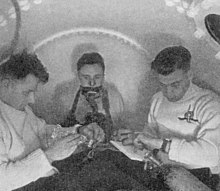
Back تسمم بالأكسجين Arabic অক্সিজেন বিষাক্ততা Bengali/Bangla Efecte de Paul Bert Catalan Iltforgiftning Danish Sauerstofftoxikose German Efecto de Paul Bert Spanish Hapniku toksilisus ET مسمومیت با اکسیژن FA Toxicité de l'oxygène French הרעלת חמצן HE
| Oxygen toxicity | |
|---|---|
| Other names | Oxygen toxicity syndrome, oxygen intoxication, oxygen poisoning |
 | |
| In 1942–43 the UK Government carried out extensive testing for oxygen toxicity in divers. The chamber is pressurised with air to 3.7 bar. The subject in the centre is breathing 100% oxygen from a mask.[1] | |
| Specialty | Diving medicine, hyperbaric medicine, neonatal medicine. |
Oxygen toxicity is a condition resulting from the harmful effects of breathing molecular oxygen (O
2) at increased partial pressures. Severe cases can result in cell damage and death, with effects most often seen in the central nervous system, lungs, and eyes. Historically, the central nervous system condition was called the Paul Bert effect, and the pulmonary condition the Lorrain Smith effect, after the researchers who pioneered the discoveries and descriptions in the late 19th century. Oxygen toxicity is a concern for underwater divers, those on high concentrations of supplemental oxygen, and those undergoing hyperbaric oxygen therapy.
The result of breathing increased partial pressures of oxygen is hyperoxia, an excess of oxygen in body tissues. The body is affected in different ways depending on the type of exposure. Central nervous system toxicity is caused by short exposure to high partial pressures of oxygen at greater than atmospheric pressure. Pulmonary and ocular toxicity result from longer exposure to increased oxygen levels at normal pressure. Symptoms may include disorientation, breathing problems, and vision changes such as myopia. Prolonged exposure to above-normal oxygen partial pressures, or shorter exposures to very high partial pressures, can cause oxidative damage to cell membranes, collapse of the alveoli in the lungs, retinal detachment, and seizures. Oxygen toxicity is managed by reducing the exposure to increased oxygen levels. Studies show that, in the long term, a robust recovery from most types of oxygen toxicity is possible.
Protocols for avoidance of the effects of hyperoxia exist in fields where oxygen is breathed at higher-than-normal partial pressures, including underwater diving using compressed breathing gases, hyperbaric medicine, neonatal care and human spaceflight. These protocols have resulted in the increasing rarity of seizures due to oxygen toxicity, with pulmonary and ocular damage being largely confined to the problems of managing premature infants.
In recent years, oxygen has become available for recreational use in oxygen bars. The US Food and Drug Administration has warned those who have conditions such as heart or lung disease not to use oxygen bars. Scuba divers use breathing gases containing up to 100% oxygen, and should have specific training in using such gases.